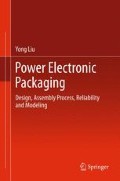Abstract
The operation of a semiconductor device is sensitive to junction temperature (Integrated circuits thermal test method environment conditions-natural convection (still air), 1995). When the junction temperature exceeds the functional limit, the device does not operate in a normal way. It is also well known that the failure rates of semiconductor devices increase exponentially as the junction temperature rises. It is very crucial that the package designer and set application engineer understand the definition, characteristics, and application of the thermal resistance of the electronic packaging for proper device operation. Power dissipation during the operation of the semiconductor device induces an increase in the junction temperature. This depends on the amount of power dissipation and the thermal resistance between the junction and the package surface (referred to as “case” hereafter), an ambient and some other specified reference point. This chapter introduces the thermal management, design, and cooling methods for power electronic packaging.
Access this chapter
Tax calculation will be finalised at checkout
Purchases are for personal use only
References
JEDEC Standard-JESD51-2 (1995) Integrated circuits thermal test method environment conditions-natural convection (still air), JEDEC Solid State Technology Association
JEDEC Standard-JESD51-3 (1996) Low effective thermal conductivity test board for leaded surface mount packages. Reproduced with permission from JEDEC, for the complete JEDEC Standard, www.jedec.org, JEDEC Solid State Technology Association
JEDEC standard-JESD51-7 (1999) High effective thermal conductivity test board for leaded surface mount packages, JEDEC Solid State Technology Association
JEDEC standard-JESD51-9 (2000) Test boards for area array surface mount package thermal measurements, JEDEC Solid State Technology Association
JEDEC standard-JESD51-10 (2000) Test boards for through-hole perimeter leaded package thermal measurements, JEDEC Solid State Technology Association
JEDEC Standard-JESD51-11 (2001) Test boards for through-hole area array leaded package thermal measurements, JEDEC Solid State Technology Association
Irving S, Liu Y, Connerny D, Luk T (2006) SOI die heat transfer analysis from device to assembly package. In: 7th International conference on EuroSimE 2006, Como, Italy
Fox RM, Lee S, Zweidinger DT (1993) The effects of BJT self-heating on circuit behavior. IEEE J Solid State Circuits 28:678–685
Brodsky JS, Fox RM, Zweidinger DT (1999) A physics-based dynamic thermal impedance model for vertical bipolar transistors on SOI substrates. IEEE Trans Electron Devices 46:2333–2339
Rinaldi N (2001) On the modeling of the transient thermal behavior of semiconductor devices. IEEE Trans Electron Devices 48:2796–2802
Su LT, Chung JE, Antoniadis DA, Goodson KE, Flik MI (1994) Measurement and modeling of self-heating in SOI NMOSFET’s. IEEE Trans Electron Devices 41:69–75
Pacelli A, Palestri P, Mastrapasqua M (2002) Compact modeling of thermal resistance in bipolar transistors on bulk and SOI substrates. IEEE Trans Electron Devices 49:1027–1033
Zweidinger DT, Fox RM, Brodsky JS, Jung T, Lee S (1996) Thermal impedance extraction for bipolar transistors. IEEE Trans Electron Devices 43:342–346
Fan XJ, Aung KT, Li X (2008) Investigation of thermal performance of various power device packages. In: Proceedings of EuroSimE 2008, Freiburg, Germany
Schulz-Harder J (2008) Review on highly integrated solutions for power electronic device. In: 5th International conference on integrated power electronics system, Nuremberg, Germany, March, 2008. Reprinted with permission from VDE VERLAG
Liu Y, Kinzer D (2011) Challenges of power electronic packaging and modeling. EuroSimE 2011, Linz, Austria (Keynote)
Author information
Authors and Affiliations
Rights and permissions
Copyright information
© 2012 Springer Science+Business Media, LLC
About this chapter
Cite this chapter
Liu, Y. (2012). Thermal Management, Design, and Cooling for Power Electronics. In: Power Electronic Packaging. Springer, New York, NY. https://doi.org/10.1007/978-1-4614-1053-9_6
Download citation
DOI: https://doi.org/10.1007/978-1-4614-1053-9_6
Published:
Publisher Name: Springer, New York, NY
Print ISBN: 978-1-4614-1052-2
Online ISBN: 978-1-4614-1053-9
eBook Packages: EngineeringEngineering (R0)

